
British Columbia is the westernmost province of Canada. Situated between the Pacific Ocean and the Rocky Mountains, the province has a diverse geography, with rugged landscapes that include rocky coastlines, sandy beaches, forests, lakes, mountains, inland deserts and grassy plains. British Columbia borders the province of Alberta to the east; the territories of Yukon and Northwest Territories to the north; the U.S. states of Washington, Idaho and Montana to the south, and Alaska to the northwest. With an estimated population of over 5.6 million as of 2024, it is Canada's third-most populous province. The capital of British Columbia is Victoria, while the province's largest city is Vancouver. Vancouver and its suburbs together make up the third-largest metropolitan area in Canada, with the 2021 census recording 2.6 million people in Metro Vancouver. British Columbia is Canada's third-largest province in terms of total area, after Quebec and Ontario.
Whistler is a resort municipality in Squamish-Lillooet Regional District, British Columbia, Canada. It is located in the southern Pacific Ranges of the Coast Mountains, approximately 125 km (78 mi) north of Vancouver and 36 km (22 mi) south of Pemberton. It has a permanent population of approximately 13,982 (2021), as well as a larger but rotating population of seasonal workers.

The Kettle Valley Railway was a subsidiary of the Canadian Pacific Railway (CPR) that operated across southern British Columbia, west of Midway running to Rock Creek, then north to Myra Canyon, down to Penticton over to Princeton, Coalmont, Brookmere, Coquihalla and finally Hope where it connected to the main CPR line.

West Vancouver is a district municipality in the province of British Columbia, Canada. A member municipality of the Metro Vancouver Regional District, West Vancouver is to the northwest of the city of Vancouver on the northern side of English Bay and the southeast shore of Howe Sound, and is adjoined by the District of North Vancouver to its east. Together with the District of North Vancouver and the City of North Vancouver, it is part of a local regional grouping referred to as the North Shore municipalities, or simply "the North Shore".
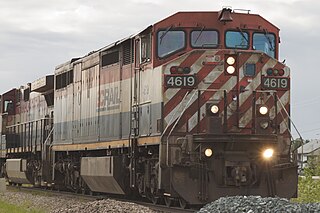
BC Rail is a railway in the Canadian province of British Columbia.

TransLink, formally the South Coast British Columbia Transportation Authority and previously the Greater Vancouver Transportation Authority, is the statutory authority responsible for the regional transportation network of Metro Vancouver in British Columbia, Canada, including public transport, major roads and bridges. Its main operating facilities are located in the city of New Westminster.

Waterfront station is a major intermodal public transportation facility and the main transit terminus in Vancouver, British Columbia, Canada. It is on West Cordova Street in Downtown Vancouver, between Granville and Seymour Street. The station is also accessible via two other street-level entrances, one on Howe Street to the west for direct access to the Expo Line and another on Granville Street to the south for direct access to the Canada Line.

Mount Garibaldi is a dormant stratovolcano in the Garibaldi Ranges of the Pacific Ranges in southwestern British Columbia, Canada. It has a maximum elevation of 2,678 metres and rises above the surrounding landscape on the east side of the Cheakamus River in New Westminster Land District. In addition to the main peak, Mount Garibaldi has two named sub-peaks. Atwell Peak is a sharp, conical peak slightly higher than the more rounded peak of Dalton Dome. Both were volcanically active at different times throughout Mount Garibaldi's eruptive history. The northern and eastern flanks of Mount Garibaldi are obscured by the Garibaldi Névé, a large snowfield containing several radiating glaciers. Flowing from the steep western face of Mount Garibaldi is the Cheekye River, a tributary of the Cheakamus River. Opal Cone on the southeastern flank is a small volcanic cone from which a lengthy lava flow descends. The western face is a landslide feature that formed in a series of collapses between 12,800 and 11,500 years ago. These collapses resulted in the formation of a large debris flow deposit that fans out into the Squamish Valley.
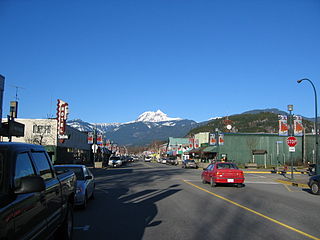
Squamish is a community and a district municipality in the Canadian province of British Columbia, located at the north end of Howe Sound on the Sea to Sky Highway. The population of the Squamish census agglomeration, which includes First Nation reserves of the Squamish Nation although they are not governed by the municipality, is 24,232.

The Canadian is a transcontinental passenger train operated by Via Rail with service between Union Station in Toronto, Ontario, and Pacific Central Station in Vancouver, British Columbia, Canada.

The Rocky Mountaineer is a Canadian rail-tour company based in Vancouver that operates luxury scenic trains on four rail routes in British Columbia, Alberta, Colorado, and Utah.
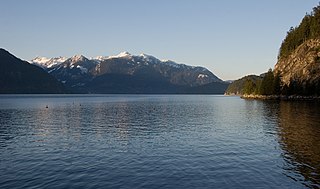
Howe Sound is a roughly triangular sound, that joins a network of fjords situated immediately northwest of Vancouver, British Columbia, Canada. It was designated as a UNESCO Biosphere Reserve in 2021.

Sea Island is an island in the Fraser River estuary in the city of Richmond, British Columbia, Canada. It is located south of the city of Vancouver and northwest of Lulu Island.
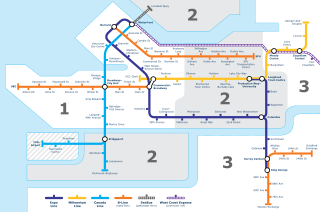
Transportation in Vancouver, British Columbia, has many of the features of modern cities worldwide. Unlike many large metropolises, Vancouver has no freeways into or through the downtown area. A proposed freeway through the downtown was rejected in the 1960s by a coalition of citizens, community leaders and planners. This event "signalled the emergence of a new concept of the urban landscape" and has been a consistent element of the city's planning ever since.

Rocky Mountaineer Station in Vancouver, British Columbia, Canada, is a railway station which acts as the western terminus of the Rocky Mountaineer train service to Jasper, Banff and Calgary. Prior to 2005, the Vancouver terminus for the Rocky Mountaineer was the Pacific Central Station.

Whistler station is a railway station located in Whistler, British Columbia, Canada, along the BC Rail line. The operations of the line are now run by Canadian National via a long-term lease between CN and BC Rail. Rocky Mountaineer runs a single train that calls at the station once a week in high season, the Rainforest to Gold Rush, which provides service from North Vancouver railway station to Quesnel railway station and Jasper railway station. Rocky Mountaineer discontinued the Whistler Sea to Sky Climb, its once-daily service to Whistler, in 2016.

Quesnel station in Quesnel, British Columbia, Canada is a railway station which is used by the Rocky Mountaineer train service. The station is used on the Rainforest to Gold Rush route that links Whistler to Quesnel. Service is infrequent and only occurs several days per month.
North Vancouver station is a railway station located in the city of North Vancouver, British Columbia, Canada and is serviced by the Rocky Mountaineer tour company. The station is used on the Rainforest to Gold Rush route that goes to Jasper. It was formerly the southern terminus of the Whistler Sea to Sky Climb.

Luxury trains are a premium passenger rail service. Some luxury trains promote tourism in destinations across a region, while others take passengers on a ride through a single country.
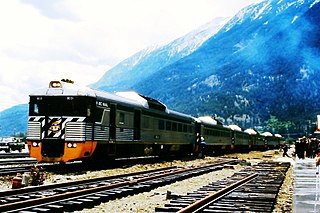
The Cariboo Prospector or Cariboo Dayliner or The BC Rail Budd cars was a passenger train service in British Columbia, Canada, which used Budd Rail Diesel Car trains. It was operated by the Pacific Great Eastern, later known as the British Columbia Railway Company and then BC Rail. The train ran from BC Rail's North Vancouver railway station, the one located a few blocks from the current North Vancouver railway station used by the Rocky Mountaineer and ran to Lillooet railway station. From there a section was split from the train that would continue down to Prince George BC Rail station located in BC Rail's Prince George yards. This train service ended along with the other BC Rail passenger services in 2002. A section serving the line between Lillooet, Seton Portage, and D'Arcy was replaced by the Koaham Shuttle.
















